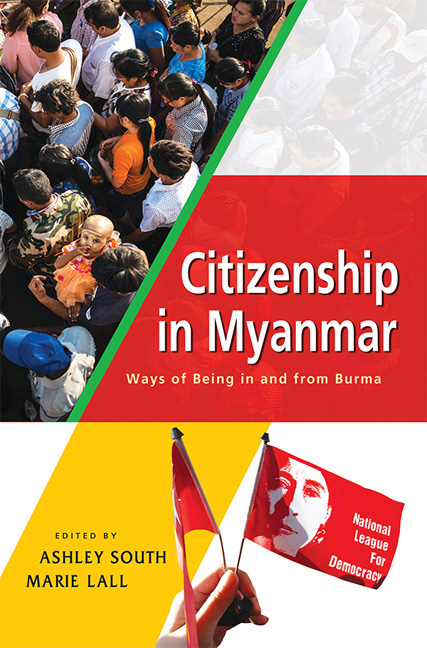Book contents
- Frontmatter
- Dedication
- Contents
- Foreword
- The Contributors
- Map of Myanmar
- Introduction
- 1 Ethnic Politics and Citizenship in History
- 2 Representation and Citizenship in the Future Integration of Ethnic Armed Actors in Myanmar/Burma
- Special Contribution: The Way Forward for Peace, Stability and Progress in Burma/Myanmar
- 3 National Political Dialogue and Practices of Citizenship in Myanmar
- 4 Citizenship and Minority Rights: The Role of “National Race Affairs” Ministers in Myanmar's 2008 Constitution
- Special Contribution: Karenni People at a Glance
- 5 Myanmar's Youth and the Question of Citizenship
- Special Contribution: I Am a Citizen of Myanmar
- 6 “The Value of Life”: Citizenship, Entitlement and Moral Legibility in Provincial Myanmar
- Special Contribution: How I Became Shan
- 7 Conflict and Mass Violence in Arakan (Rakine State): The 1942 Events and Political Identity Formation
- 8 Exploring the Issue of Citizenship in Rakhine State
- Special Contribution: Rohingya and Nationality Status in Myanmar
- 9 Myanmar's Other Muslims: The Case of the Kaman
- Special Contribution: Interview with P'doh Kweh Htoo Win
- Index
Special Contribution: Rohingya and Nationality Status in Myanmar
Published online by Cambridge University Press: 28 June 2018
- Frontmatter
- Dedication
- Contents
- Foreword
- The Contributors
- Map of Myanmar
- Introduction
- 1 Ethnic Politics and Citizenship in History
- 2 Representation and Citizenship in the Future Integration of Ethnic Armed Actors in Myanmar/Burma
- Special Contribution: The Way Forward for Peace, Stability and Progress in Burma/Myanmar
- 3 National Political Dialogue and Practices of Citizenship in Myanmar
- 4 Citizenship and Minority Rights: The Role of “National Race Affairs” Ministers in Myanmar's 2008 Constitution
- Special Contribution: Karenni People at a Glance
- 5 Myanmar's Youth and the Question of Citizenship
- Special Contribution: I Am a Citizen of Myanmar
- 6 “The Value of Life”: Citizenship, Entitlement and Moral Legibility in Provincial Myanmar
- Special Contribution: How I Became Shan
- 7 Conflict and Mass Violence in Arakan (Rakine State): The 1942 Events and Political Identity Formation
- 8 Exploring the Issue of Citizenship in Rakhine State
- Special Contribution: Rohingya and Nationality Status in Myanmar
- 9 Myanmar's Other Muslims: The Case of the Kaman
- Special Contribution: Interview with P'doh Kweh Htoo Win
- Index
Summary
EMERGENCE OF THE UNION OF BURMA/MYANMAR
Myanmar, also called Burma, is a multi-cultural and multi-lingual country. “In fact, much of Myanmar and all its borderland regions are multi-ethnic, and they have historically remained in a state of social and political flux” (Smith 1995). Based on the precept of ethnic togetherness, the independence hero the late General Aung San articulated the agreed upon union principle or policy of “unity in diversity” as the foundation of which the “Union of Burma” came into existence on 4 January 1948.
WHO ARE ROHINGYA?
Rohingya, a predominantly Muslim community, are a borderland people with a long history of living in Arakan (Rakhine) State of Myanmar. They are a people developed from diverse stocks of people over many centuries. The Rohingya have historical connections to the high cultures of Bengal, Persia and Arabia. Due to their origin and culture, as well as their present geographical location, there is no doubt that, historically, they have mixed more with Indian people than with the Burmese. The Chandra dynasty was an ancient Bengali kingdom of Arakan. Thus, Maurice Collis, who worked and lived in Burma from 1912 to 1934, writes: “Arakan was then an Indian land, its inhabitants being Indians similar to those resident in Bengal” (Collis 1985, p. 135). The group identity of the Rohingya is marked by a shared religion, geography, language and culture. They believe they are culturally distinctive and different to outsiders. They are distinguishable from the surrounding communities. However, Rakhine chauvinists and other extremists in Burma do not necessarily agree with these views: like the former military regime, most of them reject Rohingyas’ right to exist in Myanmar.
ARAKAN IN HISTORICAL PERSPECTIVE
The historical situation of Arakan in terms of the growth of its Muslim population cannot be looked at in isolation, but should be considered in the regional context. Situated in the tri-border region between modern-day Burma, India and Bangladesh, Arakan is on the frontline between the Islamic and Buddhist worlds of Asia, and amidst the Indo-Aryan and Mongoloid races.
Throughout history Arakan maintained very close ties with Muslim Bengal, which had always helped and stood by the people of Arakan in the event of any natural disaster or external aggression. Particularly, the relation between Arakan and Chittagong is influenced by geographical, ethnological, cultural and historical considerations.
- Type
- Chapter
- Information
- Citizenship in MyanmarWays of Being in and from Burma, pp. 264 - 278Publisher: ISEAS–Yusof Ishak InstitutePrint publication year: 2017



